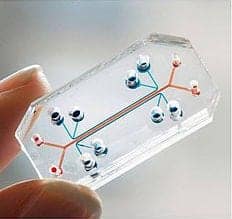The invention of the microchip has led to incredible technological advancements, and now the medical field is utilizing this technology to enhance drug testing and possibly do away with animal testing for good.
The team of biological engineers at Harvard University’s Wyss Institute for Biologically Inspired Engineering have developed a microchip technology that actually mimics human organs. These microchips are made of a flexible polymer material and are lined with human cells. This is done to create a small-scale model of an actual human organ, gauging its reaction to medication and providing a window into how these organs function.

The purpose of the chip is to test out drugs and to discover how diseases affect the body, all without invading or endangering a single human or animal life. In addition, the “organs-on-chips” allow testing to be done without compromising or wasting organs that are in high demand for transplants, such as hearts or lungs.
Many scientists have attempted to bioprint human cells or use a 3D printer to replicate internal tissue or organisms, but attempts have been unsuccessful at really creating an example of the human organs that can respond to different treatments.
Animal testing can only go so far, and human testing is often out of the question. What this “organs-on-chips” technology can do extends far beyond the current capabilities.
Related: Lab-Grown Mini Brains Shed Light on Autism
In the future, the hope is that these microchips can be used to personalize medication and treatment for specific populations. If the chips are lined with cells from a certain group of people, such as men with heartburn, treatments can be tried and tested for that specific ailment.
“Imagine you have a group of asthmatics who are female, belong to a particular ethnic group, and all have a higher sensitivity to smoke inhalation,” said Donald E. Ingber, Folkman professor of Vascular Biology and Wyss Institute director. “Maybe you could develop a drug just for that small group, using the women’s personalized chips.”
Related: 3D-Printed Blood Vessels Successfully Implanted Into Monkeys
The possibilities presented by the invention of these chips are nearly endless. The medical community has yet to see such innovation, and this technology could lead to further stem cell research, even linking multiple organs-on-chips together to see how the body would function given a certain stimulus.
The Wyss Institute hopes to eventually commercialize the microchip technology. Currently, the lung-on-a-chip is being used by Johnson & Johnson to test treatments for pulmonary thrombosis, and the kidney-on-a-chip will soon be used to test liver toxicity. While other competing technology for this type of research does exist, this new chip has a much more realistic and lifelike reaction. Chips have been developed to mimic the kidney, brain, liver, gut, bone marrow and the airways in the lungs. Future plans include building a body-on-a-chip, which would link together 10 different organs to better simulate bodily functions.
Marissa is a health and fitness writer from the Tampa Bay area. In addition to researching the latest trending topics, she enjoys instructing kickboxing classes and posting incessantly to her Instagram account.


![How To: ‘Fix’ Crepey Skin [Watch]](https://cdn.vitalupdates.com/wp-content/uploads/2017/05/bhmdad.png)












